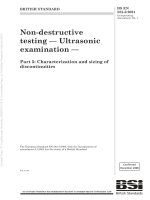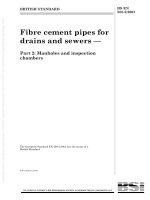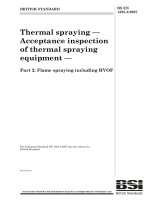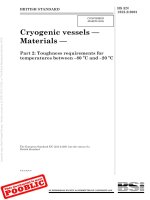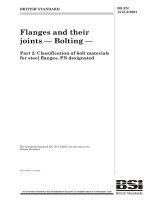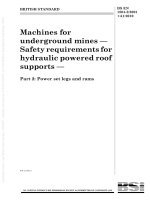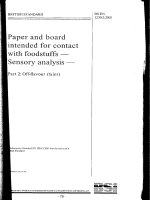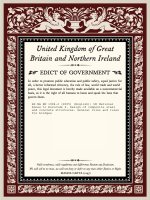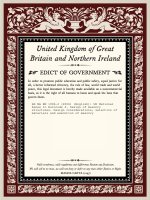Bsi bs en 00583 2 2001 (2007)
Bạn đang xem bản rút gọn của tài liệu. Xem và tải ngay bản đầy đủ của tài liệu tại đây (961.58 KB, 48 trang )
BS EN
583-2:2001
BRITISH STANDARD
CONFIRMED
DECEMBER 2007
Non-destructive
testing — Ultrasonic
examination —
Part 2: Sensitivity and range setting
The European Standard EN 583-2:2001 has the status of a
British Standard
ICS 19.100
NO COPYING WITHOUT BSI PERMISSION EXCEPT AS PERMITTED BY COPYRIGHT LAW
BS EN 583-2:2001
National foreword
This British Standard is the official English language version of
EN 583-2:2001.
The UK participation in its preparation was entrusted to Technical Committee
WEE/46, Non-destructive testing, which has the responsibility to:
—
aid enquirers to understand the text;
—
present to the responsible European committee any enquiries on the
interpretation, or proposals for change, and keep the UK interests
informed;
—
monitor related international and European developments and
promulgate them in the UK.
A list of organizations represented on this committee can be obtained on
request to its secretary.
Cross-references
The British Standards which implement international or European
publications referred to in this document may be found in the BSI Standards
Catalogue under the section entitled “International Standards Correspondence
Index”, or by using the “Find” facility of the BSI Standards Electronic
Catalogue.
A British Standard does not purport to include all the necessary provisions of
a contract. Users of British Standards are responsible for their correct
application.
Compliance with a British Standard does not of itself confer immunity
from legal obligations.
This British Standard, having
been prepared under the
direction of the Engineering
Sector Committee, was
published under the authority
of the Standards Committee
and comes into effect on
15 March 2001
Summary of pages
This document comprises a front cover, an inside front cover, the EN title page,
pages 2 to 44, an inside back cover and a back cover.
The BSI copyright date displayed in this document indicates when the
document was last issued.
Amendments issued since publication
Amd. No.
© BSI 03-2001
ISBN 0 580 37026 7
Date
Comments
EN 583-2
EUROPEAN STANDARD
NORME EUROPÉENNE
EUROPÄISCHE NORM
January 2001
ICS 19.100
English version
Non-destructive testing — Ultrasonic examination —
Part 2: Sensitivity and range setting
Essais non destructifs — Contrôle ultrasonore —
Partie 2: Réglage de la sensibilité et de la base de temps
Zerstörungsfreie Prüfung — Ultraschallprüfung —
Teil 2: Empfindlichkeits- und Entfernungsjustierung
This European Standard was approved by CEN on 5 January 2001.
CEN members are bound to comply with the CEN/CENELEC Internal Regulations which stipulate the conditions for giving this European
Standard the status of a national standard without any alteration. Up-to-date lists and bibliographical references concerning such national
standards may be obtained on application to the Management Centre or to any CEN member.
This European Standard exists in three official versions (English, French, German). A version in any other language made by translation
under the responsibility of a CEN member into its own language and notified to the Management Centre has the same status as the official
versions.
CEN members are the national standards bodies of Austria, Belgium, Czech Republic, Denmark, Finland, France, Germany, Greece,
Iceland, Ireland, Italy, Luxembourg, Netherlands, Norway, Portugal, Spain, Sweden, Switzerland and United Kingdom.
EUROPEAN COMMITTEE FOR STANDARDIZATION
COMITÉ EUROPÉEN DE NORMALISATION
EUROPÄISCHES KOMITEE FÜR NORMUNG
Management Centre: rue de Stassart, 36
© 2001 CEN
All rights of exploitation in any form and by any means reserved
worldwide for CEN national Members.
B-1050 Brussels
Ref. No. EN 583-2:2001 E
Page 2
EN 583-2:2001
Contents
Page
Foreword.............................................................................................................................3
1 Scope ..............................................................................................................................4
2 Normative references ....................................................................................................4
3 General............................................................................................................................4
3.1 Quantities and symbols..................................................................................................4
3.2 Test objects, reference blocks and reference reflectors.................................................4
3.3 Categories of test objects...............................................................................................4
3.4 Contouring of probes......................................................................................................5
4 Determination of probe index and beam angle ...........................................................7
4.1 General ..........................................................................................................................7
4.2 Flat probes .....................................................................................................................7
4.3 Probes curved longitudinally ..........................................................................................7
4.4 Probes curved transversely..........................................................................................10
4.5 Probes curved in two directions ...................................................................................13
4.6 Probes for use on materials other than non-alloy steel ................................................13
5 Range setting ...............................................................................................................13
5.1 General ........................................................................................................................13
5.2 Reference blocks and reference reflectors...................................................................14
5.3 Straight beam probes...................................................................................................14
5.4 Angle beam probes ......................................................................................................14
5.5 Alternative range settings for angle beam probes ........................................................15
6 Sensitivity setting and echo height evaluation .........................................................17
6.1 General ........................................................................................................................17
6.2 Angle of impingement ..................................................................................................18
6.3 Distance Amplitude Curve (DAC) technique ................................................................18
6.4 Distance Gain Size (DGS) technique ...........................................................................21
6.5 Transfer correction .......................................................................................................26
Annex A (normative) Table A.1 — Quantities and symbols .......................................30
Annex B (normative) Reference blocks and reference reflectors..............................32
Annex C (normative)
Determination of sound path distance and impingement
angle in concentrically curved objects ....................................35
Annex D (informative) General DGS diagram ................................................................39
Annex E (informative) Determination of contact transfer correction factors .............41
Bibliography .....................................................................................................................44
© BSI 03-2001
Page 3
EN 583-2:2001
Foreword
This European Standard has been prepared by Technical Committee CEN/TC 138,
Non-destructive testing, the Secretariat of which is held by AFNOR.
This European Standard shall be given the status of a national standard, either by
publication of an identical text or by endorsement, at the latest by July 2001, and
conflicting national standards shall be withdrawn at the latest by July 2001.
This European Standard has been prepared under a mandate given to CEN by the
European Commission and the European Free Trade Association. This
European Standard is considered to be a supporting standard to those application and
product standards which in themselves support an essential safety requirement of a
New Approach Directive and which make reference to this European Standard.
This standard consists of the following parts:
EN 583-1,
Non-destructive testing — Ultrasonic examination —
Part 1: General principles.
EN 583-2,
Non-destructive testing — Ultrasonic examination —
Part 2: Sensitivity and range setting.
EN 583-3,
Non-destructive testing — Ultrasonic examination —
Part 3: Transmission technique.
EN 583-4,
Non-destructive testing — Ultrasonic examination —
Part 4: Examination for discontinuities perpendicular to the
surface.
EN 583-5,
Non-destructive testing — Ultrasonic examination —
Part 5: Characterization and sizing of discontinuities.
ENV 583-6,
Non-destructive testing — Ultrasonic examination —
Part 6: Time-of-flight diffraction technique as a method for
detection and sizing of discontinuities.
According to the CEN/CENELEC Internal Regulations, the national standards
organizations of the following countries are bound to implement this European Standard:
Austria, Belgium, Czech Republic, Denmark, Finland, France, Germany, Greece, Iceland,
Ireland, Italy, Luxembourg, Netherlands, Norway, Portugal, Spain, Sweden, Switzerland
and the United Kingdom.
© BSI 03-2001
Page 4
EN 583-2:2001
1
Scope
This part of the standard specifies the general rules for setting the time base range and
sensitivity (i. e. gain adjustment) of a manually operated ultrasonic flaw detector with
A-scan display in order that reproducible measurements may be made of the location and
echo height of a reflector.
It is applicable to techniques employing a single contact probe with either a single or twin
transducers, but excludes immersion technique and techniques employing more than one
probe.
2
Normative references
This European Standard incorporates, by dated or undated reference, provisions from
other publications. These normative references are cited at the appropriate places in the
text and the publications are listed hereafter. For dated references, subsequent
amendments to or revisions of any of these publications apply to this European Standard
only when incorporated in it by amendment or revision. For undated references the latest
edition of the publication referred to applies (including amendments).
EN 12223,
Non-destructive testing — Ultrasonic examination —
Specification for calibration block No. 1.
EN 27963,
Welds in steel — Calibration block No. 2 for ultrasonic examination of
welds (ISO 7963:1985).
EN 12668-3,
Non-destructive testing — Characterization and verification of ultrasonic
examination equipment — Part 3: Combined equipment.
3
General
3.1 Quantities and symbols
A full list of the quantities and symbols used throughout this part of the standard is given in
annex A.
3.2 Test objects, reference blocks and reference reflectors
Requirements for geometrical features of test objects, reference blocks and reference
reflectors in general are contained in annex B.
3.3 Categories of test objects
The requirements for range and sensitivity setting will depend on the geometrical form of
the test object. Five categories of test objects are defined in Table 1.
© BSI 03-2001
Page 5
EN 583-2:2001
Table 1 — Categories of test objects
Class
1
Feature
Section in X-direction
Plane parallel surfaces
(e.g. plate/sheet)
2
Parallel, uniaxially
curved surfaces
(e.g. tubes)
3
Parallel surfaces
curved in more than
one direction
(e.g. dished ends)
4
Solid material of
circular cross section
(e.g. rods and bars)
5
Complex shapes
(e.g. nozzles, sockets)
section in Y-direction
3.4 Contouring of probes
Contouring of the probe shoe, for geometry categories 2 to 5, may be necessary to avoid
probe rocking, i.e. to ensure good, uniform, acoustic contact and a constant beam angle in
the test object. Contouring is only possible with probes having a hard plastic stand-off
(normally twin-transducer straight beam probes or angle beam probes with wedges).
The following conditions for the different geometric categories exist (see Table 1 and
Figure 1):
- category 1: No probe contouring necessary for scanning in either X- or Y-direction;
- categories 2 and 4: scanning in X-direction: Probe face longitudinally curved,
scanning in Y-direction: Probe face transversely curved;
- categories 3 and 5: scanning in either X or Y-direction:
Probe face longitudinally and transversely curved.
© BSI 03-2001
Page 6
EN 583-2:2001
The use of contoured probes necessitates setting the range and sensitivity on reference
blocks contoured similarly to the test object, or the application of mathematical correction
factors.
When using equations (1) or (2), problems due to low energy transmission or beam
misalignment are avoided.
3.4.1 Longitudinally curved probes
3.4.1.1
Convex scanning surface
For scanning on convex surfaces the probe face shall be contoured when the diameter of
the test object, Dobj, is below ten times the length of the probe shoe, lps (see Figure 1):
Dobj < 10lps
3.4.1.2
(1)
Concave scanning surface
On a concave scanning surface the probe face shall always be contoured, unless
adequate coupling can be achieved due to very large radii of curvature.
3.4.2 Transversely curved probes
3.4.2.1
Convex scanning surface
For scanning on convex surfaces the probe face shall be contoured when the diameter of
the test object, Dobj, is below ten times the width of the probe shoe, wps (see Figure 1):
Dobj < 10wps
(2)
Key
1 Transversely curved
2 Longitudinally curved
Figure 1 — Length, lps, and width, wps, of probe shoe in direction of curvature of the
test object
© BSI 03-2001
Page 7
EN 583-2:2001
3.4.2.2
Concave scanning surface
On a concave scanning surface the probe face shall always be contoured, unless
adequate coupling can be achieved due to very large radii of curvature.
3.4.3 Longitudinally and transversely curved probes
The probe face shall fulfil the requirements of 3.4.1 and 3.4.2.
4
Determination of probe index and beam angle
4.1 General
For straight beam probes there is no requirement to measure probe index and beam angle
as it is assumed that the probe index is in the centre of the probe face and the angle of
refraction is zero degrees.
When using angle probes, these parameters shall be measured in order that the position
of a reflector in the test object can be determined in relation to the probe position. The
techniques and reference blocks employed depend on the contouring of the probe face.
Measured beam angles depend on the sound velocity of the reference block used. If the
block is not made of non-alloy steel its velocity shall be determined and recorded.
4.2 Flat probes
4.2.1 Calibration block technique
Probe index and beam angle shall be determined using Calibration Block No. 1 or
Calibration Block No. 2 according to the specifications given in EN 12223 or EN 27963
respectively, depending on the size of the probe.
4.2.2 Reference block technique
An alternative technique using a reference block containing at least 3 side-drilled holes as
given in EN 12668-3 may be used.
4.3 Probes curved longitudinally
4.3.1 Mechanical determination
Before contouring the probe face, the probe index and beam angle shall be measured as
described in 4.2.1.
The incident angle at the probe face (ad) shall be calculated from the measured beam
angle (a) and a line, originating from the probe index and parallel to the incident beam,
shall be marked on the side of the probe, as shown in Figure 2.
© BSI 03-2001
Page 8
EN 583-2:2001
The incident angle is given by equation 3:
ư
ỉc
α d = arcsin ỗỗ d sin ữữ
ứ
ố ct
(3)
where:
cd
is the longitudinal wave velocity in the probe wedge (normally 2 730 m/s for
acrylic glass);
ct
is the transverse wave velocity in the test object (3 255 m/s ± 15 m/s for
non-alloy steel).
After contouring, the probe index will have moved along the marked line, and its new
position can be measured by mechanical means directly on the probe housing, as shown
in Figure 2.
The beam angle shall be determined by maximizing the echo from a side-drilled hole
satisfying the conditions given in annex B. The beam angle may then be measured directly
on the test object, on the reference block, or on a scale drawing. See Figure 3.
Alternatively, the beam angle may be determined by calculation on the basis of the sound
path length measured on the reference block by mechanical means, using equation (4).
This may be accomplished together with the range setting as described in 5.4.4.
[
ìï DSDH / 2 2 + s 2 - t 2 + sDSDH + tDObj
= arccos ớ
DObj [s + DSDH / 2 ]
ùợ
] ỹù
ý
ùỵ
(4)
The symbols used in this equation are illustrated in Figure 3.
The radius of curvature of the surface used for the calibration shall be within ±10 % of that
of the test object.
© BSI 03-2001
Page 9
EN 583-2:2001
Key
1 Marked line for index shift
2 Index point after contouring
3 Index point before contouring
Figure 2 — Determination of index shift for longitudinally curved probes
Figure 3 — Determination of beam angle = for a longitudinally contoured probe face
4.3.2 Reference block technique
This is similar to that referenced in 4.2.2, except that the test block shall have a radius of
curvature within ±10 % of that of the test object.
© BSI 03-2001
Page 10
EN 583-2:2001
4.4 Probes curved transversely
4.4.1 Mechanical determination
Before contouring the probe face the probe index and beam angle shall be measured as
described in 4.2.
After contouring, either:
i) a line representing the incident beam, originating from the probe index, shall be
marked on the side of the probe. The new position of the probe index shall be
measured on the side of the probe as shown in Figure 4;
ii) the shift in probe index position (Dx) shall be calculated using equation 5:
Dx = g tan (=d)
(5)
The symbols in this equation are illustrated in Figure 4;
iii) for acrylic glass wedges (cd = 2 730 m/s) and non-alloy steel test objects
(ct = 3 255 m/s) the shift in the probe index position (Dx), for the three most
commonly used beam angles, shall be read from Figure 5 in relation to the
depth of contouring (g).
The beam angle should not change during contouring.
However, if it is not known, or there is any variation in the depth of contouring along the
length of the probe, it shall be measured on a suitably contoured reference block using a
side drilled hole satisfying the conditions given in annex B. The beam angle shall be
determined by:
i) drawing a straight line between the hole and the probe index on a scale drawing;
or
ii) calculation using, for example, equation (6) for the set-up illustrated in Figure 6:
æ arctan A' + x - q ử
a = ỗ
ữ
t
ố
ứ
(6)
â BSI 03-2001
Page 11
EN 583-2:2001
Key
1 Marked line for index shift
2 Index point after contouring
3 Index point before contouring
Figure 4 — Determination of index shift for transversely curved probes
4.4.2 Reference block technique
This technique is similar to that referenced in 4.2.2 except that the test block shall be
curved transversely in relation to the probe, and shall have a radius of curvature not
exceeding 10 % higher, or 30 % lower, than that of the test object.
© BSI 03-2001
Page 12
EN 583-2:2001
Figure 5 — Probe index shift, Dx, for delay paths in acrylic glass
Figure 6 — Determination of beam angle using a side-drilled hole
© BSI 03-2001
Page 13
EN 583-2:2001
4.5 Probes curved in two directions
Unless the need for multiaxial curving of the probe face can be avoided, e.g. by use of
smaller probes, the procedures specified in 4.2, 4.3 and 4.4 shall be followed as
appropriate.
4.6 Probes for use on materials other than non-alloy steel
If the sound velocity in the material under test is markedly different from that in non-alloy
steel, the position of the probe index and the beam angle will be significantly changed. The
use of the radii on Calibration Block No. 1 or Calibration Block No. 2 may lead to confusing
results.
If the sound velocity is known, the beam angle can be calculated as follows:
where:
ử
ổc
t = arcsin ỗỗ t sin α r ÷÷
ø
è cr
ar
at
ct
cr
(7)
is the beam angle in a non-alloy steel reference block;
is the beam angle in the test object;
is the transverse wave velocity in the test object;
is the transverse wave velocity in the non-alloy steel reference block
(3 255 m/s ± 15 m/s).
If the sound velocity is not known, the beam angle can be determined using an echo from
a side-drilled hole in a sample of the material, as illustrated in Figure 6, or as described in
4.3.1 or in 4.4.1, as appropriate.
5
Range setting
5.1 General
For all tests using the pulse echo technique, the time base of the ultrasonic instrument
shall be set to indicate, on the screen, the sound propagation time, or, more usually, some
parameters directly related to it. Such parameters may be the sound path length of a
reflector, its depth below the test surface, its projection distance, or its shortened
projection distance, see Figure 7. Unless otherwise noted, the procedures described below
refer to setting the time base in terms of the sound path length (an echo travels this path
twice).
Time base setting shall be carried out with two reference echoes having a known time or
distance interval between them. Depending on the intended calibration, the respective
sound paths, depths, projection distances, or shortened projection distances shall be
known.
© BSI 03-2001
Page 14
EN 583-2:2001
This technique ensures that correction is automatically made for the sound propagation
time through the delay block (e.g. probe wedge). Only in the case of equipment employing
an electronically calibrated time base is one echo sufficient, provided the sound velocity of
the reference block is known.
The distance between the reference echoes shall be as large as practicable within the time
base range. The left-hand rising edge of each echo shall be set, using the time base shift
and expansion controls, to correspond to a predetermined position along the horizontal
screen graticule.
Where appropriate, calibration shall comprise a check signal, which shall not coincide with
either one of the setting signals, but shall appear at the calculated screen position.
5.2 Reference blocks and reference reflectors
For the examination of ferritic steels the use of Calibration Block No.1 or
Calibration Block No.2, as specified in EN 12223 and EN 27963 respectively, is
recommended. If a reference block or the test object itself is used for calibration, faces
opposite to the test surface or appropriate reflectors at different known sound path lengths
may be used as applicable.
Either reference blocks shall have a sound velocity within ±5 % of that of the test object, or
correction for the velocity difference shall be made.
5.3 Straight beam probes
5.3.1 Single reflector technique
This requires a reference block having a thickness not greater than the time base range to
be set. Suitable back wall echoes may be obtained from the 25 mm or 100 mm thickness
of Calibration Block No. 1, or the 12,5 mm thickness of Calibration Block No. 2.
Alternative reference blocks, having parallel or concentric surfaces, known thickness, and
the same sound velocity as the test object, may also be used.
5.3.2 Multiple reflector technique
This requires a reference block (or separate blocks) having two reflectors (e.g. side-drilled
holes) at different known sound path lengths.
The probe shall be repeatedly repositioned to maximize the echo from each reflector; the
position of the echo of the nearest reflector shall be adjusted using the shift (or zero)
control and that of the echo of the other reflector using the expansion (or distance) control
until an accurate time base setting is achieved.
5.4 Angle beam probes
5.4.1 Radius technique
Range setting can be performed using the radii reflectors of Calibration Block No. 1 or
Calibration Block No. 2, as described in EN 12223 or EN 27963 respectively.
© BSI 03-2001
Page 15
EN 583-2:2001
5.4.2 Straight beam probe technique
For transverse wave probes the range setting can be carried out using a longitudinal
straight beam probe on the 91 mm thickness of Calibration Block No. 1 (described in
EN 12223), corresponding to a sound path length of 50 mm for transverse waves in steel.
To complete the range setting it is necessary to obtain an echo, with the probe to be used
for examination, from a suitable reflector at a known sound path distance, and using the
zero shift control only, to position this echo at the correct location along the time base.
5.4.3 Reference block technique
This is similar in principle to that described in 5.3.2 for straight beam probes.
However to achieve adequate accuracy it is necessary to mark the beam index points on
the surface of the block at which each echo is first maximized, and then mechanically
measure the distance between these marks and the corresponding reflectors. For all
subsequent time base adjustments, the probe shall be repositioned on these marks.
5.4.4 Contoured probes
Range setting shall first be performed using a probe with a flat face, as described above.
The contoured probe shall then be positioned on a suitable contoured reference block
having at least one reflector at a known sound path length. The position of the echo from
this reflector is adjusted to the correct position along the time base using only the shift
control.
5.5 Alternative range settings for angle beam probes
5.5.1 Flat surfaces
Instead of setting in terms of sound path length, the time base may be set to indicate
directly the depth of a reflector below the test surface, or its distance in front of the probe,
see Figure 7.
Therefore, having selected the time base in terms of depth or projection distance, the
echoes from the reference block, at known sound path lengths, are set along the time
base at the positions corresponding to the equivalent depths, or projection distances,
which may be determined as follows:
For a flat plate they may be determined for a given beam angle, either from a scale
drawing, or from the following equations:
- depth (t):
- projection distance (a):
- shortened projection distance (a'):
© BSI 03-2001
t = s cos at
a = s sin at
a' = (s sin at) - x
(8)
(9)
(10)
Page 16
EN 583-2:2001
5.5.2 Curved surfaces
Whilst the same principles of range setting described in 5.5.1 still apply, the time base is
not linear with respect to depth or projection distance.
A non-linear graticule scale may be constructed by taking measurements at a number of
positions on a scale drawing of the sound path, or by calculation using suitable equations.
The sound path distance to the opposite surface of a concentrically curved object may be
determined using the equations given in annex C.
Alternatively, the graticule intervals may be determined on the basis of the maximized
echoes from a series of reflectors in a curved reference block, the intermediate values
being obtained by interpolation. See Figure 8.
Key
1 Reflector
2 Index point
Figure 7 — Definitions for setting of the time base in terms of
e.g. reduced projection distance
© BSI 03-2001
Page 17
EN 583-2:2001
Figure 8 — Example of screen graticule for location of reflectors
with a time base set in terms of reduced projection distance and depth
(here: at = 51°°, smax = 100 mm)
6
Sensitivity setting and echo height evaluation
6.1 General
After the time base has been calibrated, the sensitivity (or gain adjustment) of the
ultrasonic equipment shall be set using one of the following techniques.
1) Single Reflector technique
A single reference reflector, e.g. a back wall, or a notch, may be used when
evaluating echoes occurring within the same range of sound path distance.
2) Distance Amplitude Curve (DAC) technique
This technique uses the echo heights from a series of identical reflectors
(e.g. side-drilled holes or flat-bottom holes) at different sound path lengths in
suitable reference blocks (see 6.3).
3) Distance Gain Size (DGS) technique
This technique uses a series of theoretically derived curves relating the sound path
length, the equipment gain, and the size of a disk-shaped reflector perpendicular to
the beam axis (see 6.4).
© BSI 03-2001
Page 18
EN 583-2:2001
Techniques 2 and 3 attempt to compensate for the change in the echo height from a
reflector with increasing sound path distance. However, for all three techniques, a transfer
correction shall be applied, where necessary, to compensate for any coupling losses and
differences in material attenuation (see 6.5).
Using ideal reflectors of simple shape, e.g. side-drilled holes or flat bottom holes, for sizing
of natural discontinuities, will not give the true size but only an equivalent value. The true
size of the real discontinuity may be much larger than this equivalent value.
6.2 Angle of impingement
When using angle probes on curved test objects in conjunction with indirect scanning
(i.e. after the ½ skip position), the incident angle at the back wall, i.e. the angle of
impingement, should be considered. In the case of cylindrical components scanned from
the outer surface, the incident angle at the inner surface may be very much larger than the
beam angle. Conversely, when scanning from the inner surface, the incident angle at the
outer surface may be very much smaller than the beam angle (see annex C).
For transverse wave probes, the beam angle shall be chosen to avoid impingement angles
outside the range 35° to 70°, because in that case severe loss in sound energy will occur
due to mode conversion. Moreover, additional echoes from other wave modes may disturb
echo evaluation.
A technique for determining the impingement angle at the inner and outer surfaces of a
cylinder is described in annex C together with methods of calculating the sound path
distance to the opposite surface.
6.3 Distance Amplitude Curve (DAC) technique
6.3.1 Reference blocks
A DAC reference block is required having a series of reflectors at different sound path
distances over the time base range to be used for the test. Details of the spacing and
minimum size of block and reflectors are given in annex B.
The specifications given in annex B apply for category 1 objects, and, where appropriate,
for category 2 to category 5 test objects.
It should be noted that there are minimum sound path lengths below which signals cannot
be satisfactorily evaluated due to e.g. dead zone effects or near field interference.
The DAC reference block shall be either:
1) a general purpose block of uniform low attenuation and specified surface finish,
and having a thickness within ±10 % of the test object; or
2) a block of the same acoustic properties, surface finish, shape and curvature as
the test object.
In the case of type 1), correction for any differences in attenuation, curvature and coupling
losses may be necessary before the Distance Amplitude Curve can be directly applied.
© BSI 03-2001

